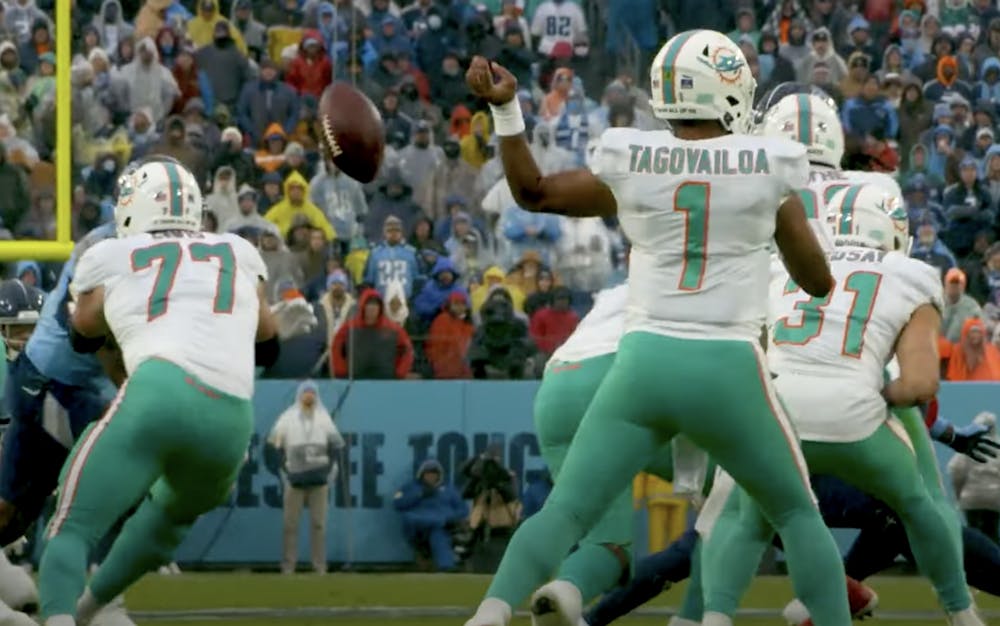
There has never been a closer focus on preventing injuries in the National Football League (NFL). From preventative penalties to independent certified athletic trainers (ATC spotters), the league has made it their priority and practically their mission statement to catch injuries as fast as possible, stop the game and get the player off the field. This was not the case this past week.
In two separate instances, two players — Cameron Brate and Tua Tagovailoa — were put back on the field after suffering concussions.
In Tampa Bay tight end Brate’s case, after a head-on collision with his teammate Chris Godwin in the second quarter on Sunday, Oct. 9, he was put back on the field without a visit to the medical tent. During halftime he was tested and put into concussion protocol, sitting the rest of the game out.
On his way back up from his collision, Brate was obviously disoriented. After laying down for a while on the field, he was helped to his feet by offensive tackle Tristan Wirfs and even ran into an official on his way jogging off the field. According to Tampa Bay’s head coach Todd Bowles, Brate complained of discomfort in his shoulder without any mention of head trauma, so he wasn’t thoroughly tested or put into concussion protocol. After complaining about some head trauma during halftime, he was put into protocol and ruled out.
Tagovailoa, quarterback for the Miami Dolphins, got a lot more attention with his two-part injury. On Sunday, Sept. 25, in the Dolphins’ game against the Buffalo Bills, Tagovailoa was tackled by linebacker Matt Milano, and his head bounced off the turf. After getting up relatively quickly, Tagovailoa stumbled while jogging back to the line of scrimmage and had to be held up by his teammate, offensive tackle Liam Eichenberg, while staff rushed onto the field. Even though his head hit the ground and his limbs looked weak and staggering, which indicates that some head trauma had occurred, the Dolphins let Tagovailoa re-enter the game and later listed the incident as a back injury.
In just four days, on Sept. 29, Tagovailoa was back on the field. Unfortunately, in the second quarter, Tagovailoa was swung down by Cincinnati defensive tackle Josh Tupo and suffered a very disturbing brain injury, which caused his forearms and fingers to flex and posture in an unnatural position — a sign of serious trauma.
Following the backlash of these events, the National Football League Players Association (NFLPA) launched an investigation into the Miami Dolphin’s use of concussion protocol and fired the independent neurological expert who cleared Tagovailoa to play on Sept. 29. The loophole they seemingly used to allow Tagovailoa back into the game was by attributing the injury to his back.
The situation could have been similar to Brate’s situation, where Tagovailoa only told of back pain, so they didn’t properly test for a concussion. These are all assumptions, and whether the staff was aware of any signs of concussions remains to be seen, but either way these cases pose a big scandal for their separate teams and the NFL as a whole.
I, like many other NFL fans, have been subjected to countless advertisements and propaganda from the NFL on their extensive protocols to prevent injury and ensure the safety of the players. They shove showy presentations of the so-called “Next Generation of NFL Player Safety,” claiming that with the help of new technology and “simulations,” they can prevent extreme injuries. Where these seemingly intensive studies have actually been utilized is less than obvious.
This past offseason, new helmets called “Guardian Caps” were implemented for high-collision positions (offensive linemen, running backs, tight ends, defensive linemen and linebackers), with extra padding supposedly lessening the impact on an individual player by at least 10%. Besides this move, there have been no announcements on the pads players wear, and the Guardian Caps themselves are only used in practice. The NFL’s “revolutionary” new approach to injury prevention has been less than satisfactory, to say the least.
As the two specific instances with Tagovailoa and Brate indicate, all these new technologies, paired with the actual preventative measures put in place, don’t actually prevent anything unless the policies are enforced and followed effectively. ATC spotters, a system of people solely dedicated to reviewing injuries for signs of concussions or other serious brain trauma, and independent neurologists both have to do their job properly and not rely on the self-reported symptoms of players.
In the case of Brate, the head-to-head collision should have been enough to check thoroughly for a concussion, but the ATC spotter(s) — supposedly watching for such things — either completely missed it or chose to believe Brate that it was only a shoulder issue. With Tagovailoa, it remains to be seen what went wrong, but clearly the protocol was not followed properly, as the concussion was never detected or reported.
Either independent neurologists are not reliable enough to enforce and follow these protocols, creating the need for a more organized system of medical professionals, or the NFL should have NFL employees there during the process to make sure the policies are being properly followed.





